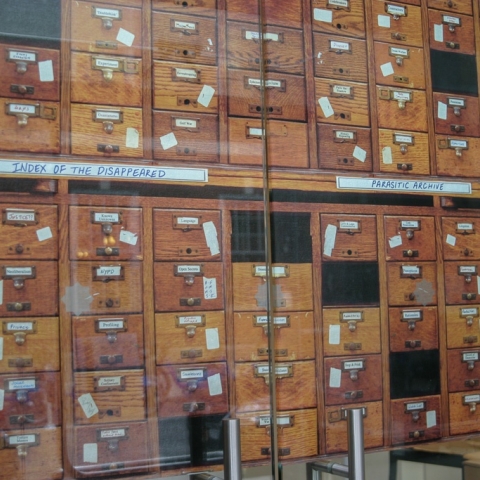What we left unfinished is a series of texts, photographs, sketches and films investigating two interrelated phenomena: unfinished films from three periods of political turbulence and regime change in Afghanistan (1977, 1978-79, and 1989-92), and unfinished political projects from revolution to reconciliation, as reflected in or refracted through those films and fragments. What we left unfinished developed from earlier and ongoing research in the archives of Afghan Films, Afghanistan's national film institute, as part of my engagement with new initiatives to catalogue and digitize the film archives, which led to writing about and curating screening programs with films from the archives. During the course of this research, I discovered that between ten and fifteen feature films were shot, but never completed, during three different periods of political turbulence: 1977 (the end of Daoud's republic), 1978-79 (the Communist coup, Communist party split, and Soviet invasion), and 1989-92 (the transition from Karmal to Najib and handover from Najib to the mujahidin coalition government). Because all of these films were produced by Afghan Films, the state-funded film institute, they all reflect (to different degrees) the imaginary and desires of the state in the moment of their making. Because they remain in a raw state, they can be examined as documents of those desires, having never been assembled into fully realized works that hide their seeds behind the full bloom of their art.
My initial research indicates that almost all the original directors are still alive, though some have emigrated to other countries, and some of the footage is also physically located in other archives (usually because it was being processed in another country at the moment of transition in Afghanistan), though the copyright resides with the Afghan Films archive. Building on my ongoing work with the archive, I will find out as much as possible about the films as originally conceived – tracking down whatever scripts, notes, directors, writers, crew, and cast may still be around. Regardless of what research reveals, though, some invention will be necessary, both to fill in the gaps and connect the disparate pieces into a new whole. This process of reconstruction from scattered and partial information – a combination of induction and intuition – parallels the process through which the history of this period is gradually, gingerly being recovered. Like the aesthetic intentions of the original filmmakers, the political intentions of the leaders who commissioned the films – the Afghan Communists who are remembered more for their ends than their beginnings, more for their excesses than their ideals – have been obscured by the passage of time. The footage left behind is a trail of visible evidence leading back to those original intentions, making it possible for us to reconstruct not the truth of how the state existed and acted in that moment, but rather its fiction – the state's own image of how it should have been, and on some level, what it desired from itself and its citizens. Part of the process of constructing the project will be both uncovering those intentions, and discovering a way to represent them alongside our present-day knowledge of how those intentions deteriorated into actions less pure, or the reality the fiction concealed.
Ultimately, I would like to construct a new feature-length film from some or all of these unfinished films – a film that could tell, whether obliquely or directly, the story of those years that remade Afghanistan so radically – but I am not sure whether that will still appear as the most desirable, or even possible, outcome once the research process is complete. In part because of this uncertainty, What we left unfinished will also unfold as a self-reflexive examination of the process and ethics of archival research, of what it means to engage with an archive over a long period of time, of the stakes and effects of exploiting existing works (even in fragmentary form), and of the multivalent exchanges between artists and archives.
The Radical Archive is a series of public programs, projects and texts around the idea of the radical archive, which includes both archives of radical politics and practices, and also archival practices that apply radical methods to the construction, organization, growth, and maintenance of archives. Framing archiving as a radical practice is also intended to consider whether archiving, as a practice of sustained and focused attention to and preservation of things and moments that might otherwise be lost, is in itself a radical act in an economy of continuous partial attention to and generation of streams of content designed to disappear.
Index of the Disappeared (Chitra Ganesh & Mariam Ghani) will be artists in residence at the Asian Pacific American Institute at NYU from September 2013 to May 2014. During that time we will be working on a series of projects with A/P/A and the broader New York University (NYU) community, linked by the theme of archiving as a radical practice. The residency began in October with a talk about the Index archive and the idea of "warm data," which we developed for the project and which has been taken up by queer and diasporic theorists. We will then convene a meeting of NYU faculty, staff and students working with archives – this is a large and diverse group, which includes the Tamiment labor/socialist archives (which now also hold the papers of most of the Guantanamo lawyers), the Fales downtown archives (Exit Art, Artist Space, Group Material, Fashion Moda, the East Village squats, the Riot Grrl papers), the Moving Image Archive program (faculty and students worked on the Occupy movement archives, and public TV archives in the US, Africa and Latin America), the Kevorkian Institute for Near Eastern Studies (which has the Jack Shaheen archive of Orientalist representations in popular culture, among other things), and the A/P/A Institute itself, which is spearheading a national initiative to digitize archives of Asian American art. From this initial meeting we will develop a plan for the conference in April 2014, which will include an international contingent of archivists, artist-archivists, and those who mine/subvert/reconstruct existing archives in interesting ways. The Index archive will also appear in several different places and ways around the campus, including a series of window installations at the Kimmel Center, and as a pop-up, parasitic, adaptive library-within-a-library installation in the Kevorkian and Tamiment archives. Finally, we will be producing a new radical archive by working with lawyers & advocates from the Center for Constitutional Rights to organize an exhibition of Guantanamo detainee drawings and poetry, write about the phenomenon of art classes on Guantanamo, and produce some kind of publication.
About the artist

Mariam Ghani's research-based practice spans video, installation, performance, photography, and text. Her exhibitions and screenings include the Rotterdam, transmediale, and CPH:DOX film festivals, dOCUMENTA (13) in Kabul and Kassel, MoMA in New York, the National Gallery in DC, and the Sharjah Biennials 10 and 9. Recent texts have been published by Filmmaker, Foreign Policy, Mousse, the Radical History Review, Triple Canopy, Creative Time Reports, and the New York Review of Books blog. Ongoing collaborations include the experimental archive Index of the Disappeared (with Chitra Ganesh), the video series Performed Places (with choreographer Erin Kelly), and the Afghan Films online archive (with pad.ma).
Ghani has been awarded the NYFA, Soros and Freund Fellowships, grants from the Graham Foundation, CEC ArtsLink, the Mid-Atlantic Arts Foundation and the Experimental Television Center, and residencies at LMCC, Eyebeam Atelier, Smack Mellon and the Akademie Schloss Solitude. Ghani holds a B.A. in Comparative Literature from NYU and an MFA from SVA. She currently teaches at Pratt and is an artist in residence at the Asian/Pacific/American Institute at NYU.
